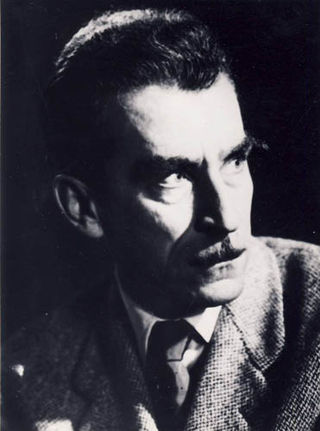
Modern lyric poetry is a formal type of poetry which expresses personal emotions or feelings, typically spoken in the first person. The term for both modern lyric poetry and modern song lyrics derives from a form of Ancient Greek literature, the Greek lyric, which was defined by its musical accompaniment, usually on an instrument known as a kithara, a seven-stringed lyre. These three are not equivalent, though song lyrics are often in the lyric mode and Ancient Greek lyric poetry was principally chanted verse.

Tamiki Hara was a Japanese writer and survivor of the bombing of Hiroshima, known for his works in the atomic bomb literature genre.
Sadako Sasaki was a Japanese girl who became a victim of the atomic bombings of Hiroshima and Nagasaki by the United States. She was two years of age when the bombs were dropped and was severely irradiated. She survived for another ten years, becoming one of the most widely known hibakusha—a Japanese term meaning "bomb-affected person". She is remembered through the story of the more than one thousand origami cranes she folded before her death. She died at the age of 12 on October 25, 1955, at the Hiroshima Red Cross Hospital.

Hibakusha is a word of Japanese origin generally designating the people affected by the atomic bombings of Hiroshima and Nagasaki by the United States at the end of World War II.

The Hiroshima Panels are a series of fifteen painted folding panels by the collaborative husband and wife artists Toshi Maruki and Iri Maruki completed over a span of thirty-two years (1950–1982). The Panels depict the consequences of the atomic bombings of Hiroshima and Nagasaki, as well as other nuclear disasters of the 20th century. Each panel stands 1.8 metres x 7.2 metres.

Peter Gizzi is an American poet, essayist, editor and teacher. He attended New York University, Brown University and the State University of New York at Buffalo.
Hugh McFadden is an Irish poet, literary editor, lecturer and freelance journalist.

On 6 and 9 August 1945, the United States detonated two atomic bombs over the Japanese cities of Hiroshima and Nagasaki, respectively. The bombings killed between 150,000 and 246,000 people, most of whom were civilians, and remain the only use of nuclear weapons in an armed conflict. Japan surrendered to the Allies on 15 August, six days after the bombing of Nagasaki and the Soviet Union's declaration of war against Japan and invasion of Japanese-occupied Manchuria. The Japanese government signed the instrument of surrender on 2 September, effectively ending the war.

Substantial debate exists over the ethical, legal, and military aspects of the atomic bombings of Hiroshima and Nagasaki on 6 August and 9 August 1945 respectively at the close of the Pacific War theater of World War II (1939–45).
Sadako Kurihara was a Japanese poet who lived in Hiroshima and survived the atomic bombing during World War II. She is best known for her poem Umashimenkana.

Eugen Jebeleanu was a Romanian poet, translator, journalist, and scholar.
This is a list of cultural products made about the atomic bombings of Hiroshima and Nagasaki. It includes literature, film, music and other art forms.

Tsutomu Yamaguchi was a Japanese marine engineer who survived both the Hiroshima and Nagasaki atomic bombings during World War II. Although at least 160 people are known to have been affected by both bombings, he is the only person to have been officially recognized by the government of Japan as surviving both explosions.
Atomic bomb literature is a literary genre in Japanese literature which comprises writings about the atomic bombings of Hiroshima and Nagasaki.
Sankichi Tōge, born Mitsuyoshi Tōge, was a Japanese poet, activist, and survivor of the atomic bombing of Hiroshima. He is best known for his collection of poems Genbaku Shishu, published in 1951.
Nagasaki is an oratorio composed by Soviet composer Alfred Schnittke in 1958, at the age of 25. It was Schnittke's graduation composition in the Moscow Conservatory, and the topic was suggested by his teacher Evgeny Golubev.

Brandon Shimoda is an American poet. He is the author of several poetry collections, including O Bon and Evening Oracle, as well as the memoir The Grave on the Wall. A professor at Colorado College, Shimoda is also the creator of the Hiroshima Library.

Evening Oracle is a 2015 poetry collection by Brandon Shimoda, published by Letter Machine Editions. It won the William Carlos Williams Award.

The Grave on the Wall is a 2019 memoir by Brandon Shimoda, published by City Lights. It won the PEN Open Book Award.

Hydra Medusa is a 2023 poetry collection by Brandon Shimoda, published by Nightboat Books.













